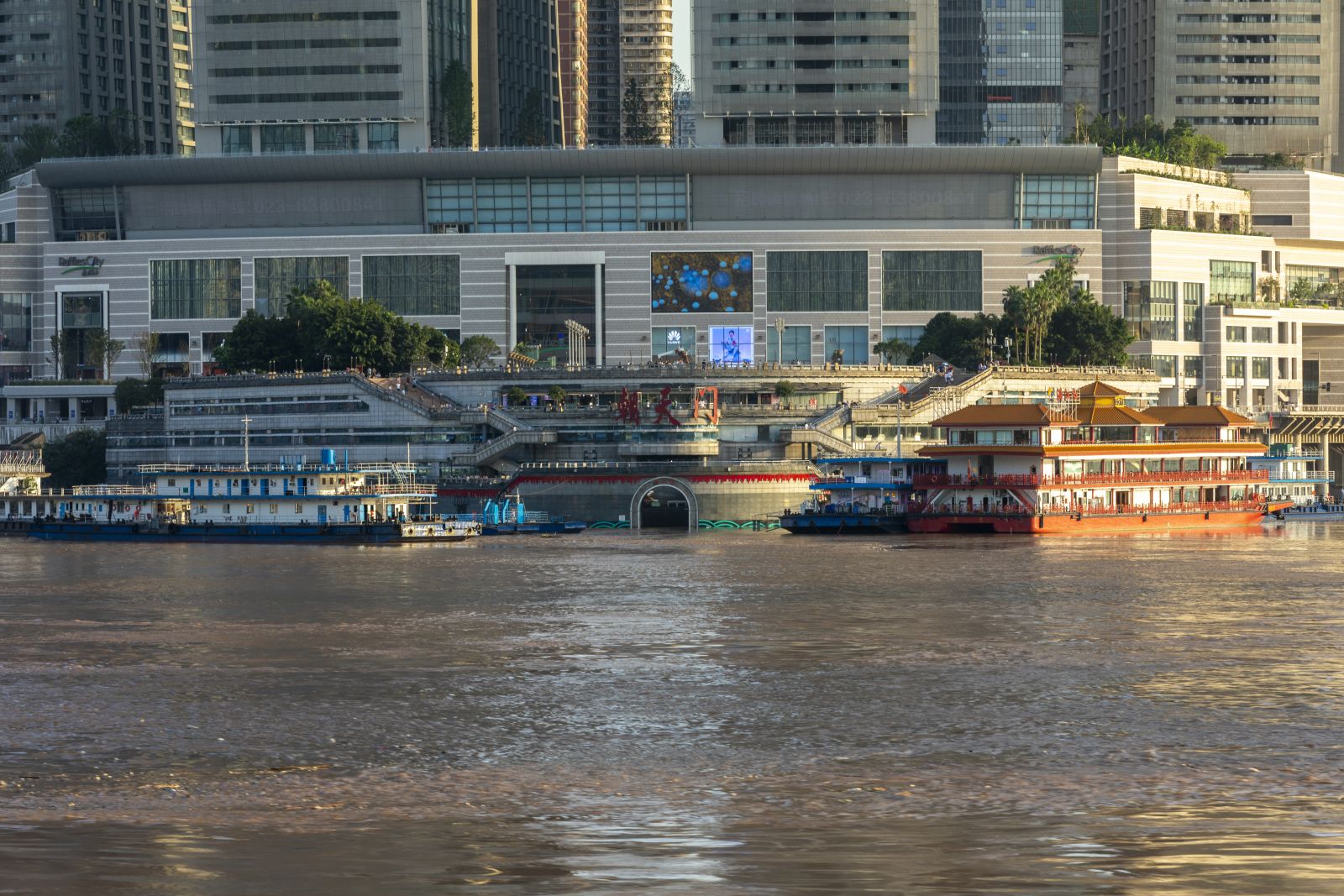Chinese Name: 朝天门码头 Pronunciation: Cháotiānmén Mǎtóu
Building Time: 1927
Opening Hours: All day
Suggested Visiting Hours: 1-2 Hours
Admission Ticket Fare: Free of charge
Best Visiting Time: Summer and Autumn (June to November)
Address: No.17, Changbin Road, Yuzhong District, Chongqing
Building Function: A place where Chongqing local officials met edicts of the emperors or received significant officials of the imperial court in ancient times and a place used for a ferry to disembark passengers and goods.
Chaotianmen Dock (Chaotianmen means Chaotian Gate) is located at the intersection of Jialing River and Yangtze River in the Yuzhong Peninsula of Yuzhong District in Chongqing. On the left side of the Chaotianmen Dock, Jialing River, one of the nine main tributaries of the Yangtze River, converges with the Yangtze River and flows thousands of miles into the East China Sea. The altitude of low water level is only 160 meters, which is the lowest in the urban area.
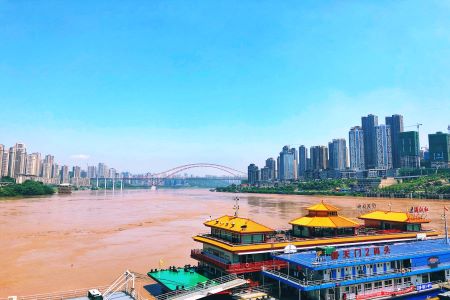
It is said that in ancient times ordinary civilian ships were not allowed to dock at the Chaotianmen Dock. Then, to assist river traffic, ordinary civilian ships were allowed to dock at the nearby small docks and the largest and best docks were still reserved for official ships. Later, due to the unique geographical location of Chaotianmen Dock, it gradually became the most representative wharf in early Chongqing and can be used by civilian. The water transportation is busy day and night. Outside Chaotian Gate there are plenty of shantytowns and stilted buildings. Inside Chaotian Gate there are streets and alleys with roads reaching to all destinations making the area bustling and prosperous. Looking along the riverbanks on both sides of the Chaotianmen Dock, the architectural style of the stilted buildings in old Chongqing is still preserved which is in sharp contrast with the bright lights of the metropolis.
Chaotianmen Dock enjoys rich tourism resources and receives millions of tourists every year. To meet the huge demand of the Three Gorges tourism market, the Chaotianmen Dock is full of all kinds of cruise ships. There are a great number of wharves on the riverside. At Chaotianmen Dock thousands of visitors are transported to visit the spectacular Three Gorges of the Yangtze River every day.
In 314 B.C., Chaotian Gate was built when general Zhang Yi of the Qin Dynasty(221 BC-207 BC) built Bajun city.
In 1891, Chongqing became a commercial port, and a customs office was set up at Chaotian Gate.
In 1927, due to the reconstruction of Chaotianmen Dock, the old city gate was removed.
In 1949, a fire turned the area 2 square kilometres nearby Chaotian Gate into a ruin. Since then, Chaotian Gate has been surrounded only by walls.
After 1949, the Chaotianmen Dock was extended.
On the last day of 1998, Chaotian Gate Plaza, which took 300 days to build, was completed and open to the public. As soon as it appeared, it became a new landmark of Chongqing.
In May 2016, Chaotian Gate was elected as one of the Top Ten Cultural Symbols in Chongqing.

As one of the seventeen ancient gates in Chongqing, Chaotian Gate has a long history. In ancient times, it functioned as a place where Chongqing local officials met the emperor's edicts or received important officials. And the emperor was considered as the son of heaven, so the gate was called Chaotian Gate, meaning “towards the heaven gate”. There were four inscriptions--- “Gu Yu Xiong Guan” on the old Chaotian Gate, which means the gate was an impregnable pass of Chongqing in ancient times. As time passed by, In order to expand the scale of the city and solve the problems of narrow streets and traffic congestion, the old gate was demolished. The Chaotian Gate at present is newly built.
Chaotian Gate, one of the nine gates along the Yangtze River in Chongqing, is located at the southeast part of Chongqing. Chaotian Gate is the largest and most magnificent gate with the most wonderful scenery. It is surrounded by water on three sides and backed by mountains on one side. So it is a must-go place when you visit Chongqing.
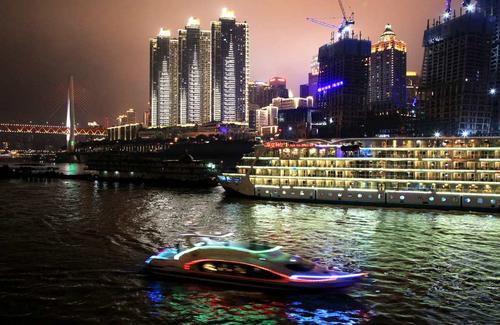
As a landmark building with the functions of waterway hub, tourism, and leisure as a whole, the Chaotian Gate Plaza is located in the northeast of Yuzhong District. Looking from a distance, Chaotian Gate Plaza is like a huge ship sailing far away, so it is also known as the “Titanic” of Chongqing. Standing on the square people can have a panoramic view of the city as well as the intersection of the two rivers. The yellow water of the Yangtze River and the green water of Jialing River are quite distinct from each other at the intersection, forming a unique landscape known as the "golden water section" of the Yangtze River.
Covering a total area of 80,000 square meters, the Chaotian Gate Plaza is composed of four parts: sightseeing square, revetment terrace, traffic square and surrounding equipment. In front of the Chaotian Gate Plaza, the green Jialing River meets the brown Yangtze River. To the east of the plaza there is the magnificent Chongqing Grand Theatre in Jiangbei District and to the west is the brilliantly illuminated Nanbin Road. This plaza is a leisure place for local people. When the weather is fine many people fly kites here. Chaotian Gate Plaza is also a good place to see the night scene of Chongqing with illuminated dock and the brightly-lit cruise ships.
Chaotian Gate Plaza was built and open to people in 1998. On the square there is a stele with the name of the square inscribed by former President Jiang Zemin. The "Zero Kilometrer" sign of the Chongqing highway is located in the plaza. "Zero Kilometre" is the starting point of the counties or city’s trunk road, and also the symbol of the city center. Since its appearance, Chaotian Gate Plaza has become the most representative building in Chongqing.
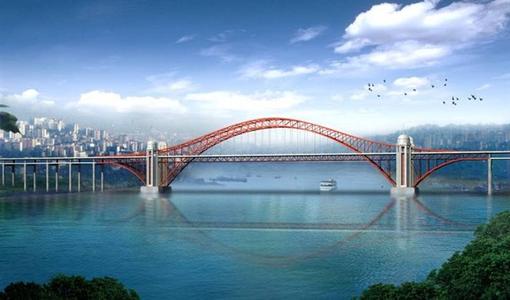
Chaotianmen Yangtze River Bridge is an important river-crossing bridge connecting Jiangbei District and Nan'an District in Chongqing. It is located on the Yangtze River waterway and is an east-west expressway. The bridge is designed as a steel truss arch bridge with two main piers and with a total length of 1,741 meters. After its completion, it was said to be the world's largest span arch bridge, known as the "World's First Arch Bridge".
Chaotianmen Yangtze River Bridge is coloured with red except for the piers. There are few piers into the water, so it does little damage to the river landscape. At the beginning of the planning, it was designed as the Gate of the City on the River. Through this city gate, people can see the scene of Yuzhong Peninsula, with excellent landscape.
Chaotianmen Yangtze River Bridge was originally called Wangjiatuo Yangtze River Bridge. Later it was named Red Crag Yangtze River Bridge, which was changed to its current name in February 2004. In December 2004, the construction of the Chaotianmen Yangtze River Bridge started. On April 29, 2009, the bridge was officially open to traffic. The bridge was rated as the "One Hundred Classic Projects in 40 years of Reform and Opening-up" by China Construction Industry Association in 2019. The completion and opening of Chongqing Chaotianmen Yangtze River Bridge play an important role in improving the traffic network of the main urban area.
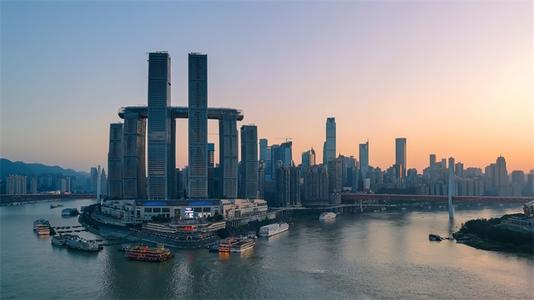
Raffles City Chongqing is a leisure plaza with several special buildings located between Chaotian Gate Plaza and Liberation Monument. Its geographical position is incomparable and important in Chongqing. It integrates all kinds of public transportation facilities of land and water transportation. With a total investment of more than 24 billion yuan and a total construction area of more than 1.12 million square metres, it is the largest investment project of Singapore in China and has been put into use since 2019. After its completion, it has become the tallest building in Chongqing and a new landmark in Chongqing as well as in Southwest China. In 2019 the shopping center of Raffles City Chongqing has been officially opened. In 2020, it was elected as the "Ten New Cultural and Tourism Landmarks of Chengdu and Chongqing".
There are eight towers standing on the Raffles City. The shape of the Raffles City Chongqing looks like "sailing towards the sky", which is designed by the world-famous architect Moxi Safdie. The design inspiration of the towers originates from the shipping culture accumulated in Chongqing over thousands of years. The eight arc-shaped towers all faces the north. Looking far away, the tall buildings with a height of 350 meters or 250 meters are like giant ships sailing on the river riding the wind and waves.
There is a 300-meter-long crystal corridor in the Raffles City Chongqing spanning the top of four towers and connecting six towers with a distinctive structure with clear crystal glass. In the corridor bridge you can have a panoramic view of Chongqing's rivers and mountains. At an altitude of 250 meters, there are comfortable and spacious entertainment and leisure places such as viewing platforms, clubs, and dining areas. At night, the corridor is like a bright glass ribbon standing in the water area.
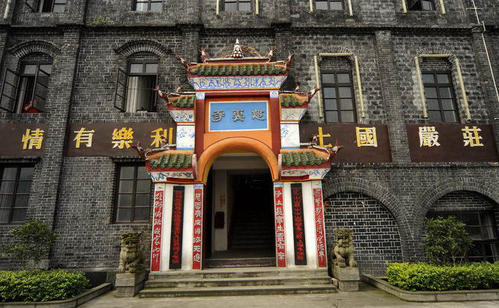
Ciyun Temple, located on the lion mountain of Nan’an District near Chaotianmen Dock, is a national key temple, which is now managed and used by the Buddhist community. On the left side of the gate lies a stone gray lion, facing the White Elephant Street on the other side of the Yangtze River. Founded in the Tang Dynasty and rebuilt in 1757, the temple was originally named Guanyin Temple. It was expanded in 1927 and renamed Ciyun Temple. It was the only Buddhist temple with monks and nuns in China at that time. Ciyun Temple mixes a special architecture with both Chinese and Western styles, which is unique among Chinese Buddhist temples.
Ciyun Temple is close to the Yangtze River, whose halls are built and arranged along the mountain. The buildings of the temple, the surrounding gardens, and mountains are all very beautiful, and the environment is tranquil. It has become a famous tourist attraction in Chongqing. As you enter the temple gate and walk along the stone steps, you will see a majestic building called Daxiong Hall. Climbing up the hill along the quiet road there is a big garden on the top of the hill. The architectural style of the temple is the integration of modern European building art and ancient Chinese building art which makes the temple unique in architecture.
There are many Buddhist relics in Ciyun Temple. Among them the most famous one is the statue of Sakyamuni Jade Buddha, one of the largest in China, with a height of 1.87 metres and a weight of 1,500 kg. There is also a bodhi tree transplanted from India in the early period of the Republic of China, which died during the Cultural Revolution(1966-1976). Unexpectedly the bodhi tree miraculously came back to life in the last 10 years which made the pilgrims and monks incredibly surprised. As a result, more and more visitors are attracted by it and always come here to make a wish.
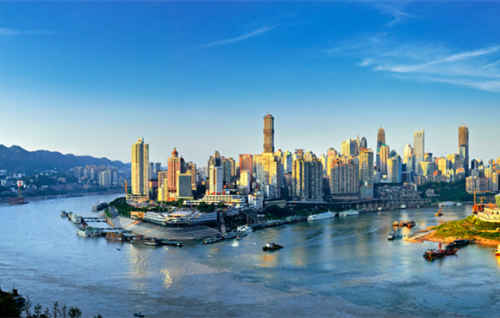
Chaotianmen Dock is located at the intersection of the two rivers. It is essential to enjoy the scenery of the two rivers when you come here. There is a white tower in the east of the Chaotian Gate. It is a kind of mascot named "Zhenyao Pagoda" (a pagoda to suppress demons) built by ancient people who longed for a stable life. They are built on the way to the city which means that good people could enter the city, but all demons and monsters cannot pass by.
There is a cable car shuttling back and forth over the Jialing River which was completed in 1981 with a total length of 740 meters. It is one of the unique short-distance transportation methods in a mountain city like Chongqing. It is mainly designed for the passengers to solve the problem of climbing the stone steps. It can carry 46 passengers each time. In early summer and mid-autumn, the water of the Jialing River is green, and the water of the Yangtze River is yellow, and they intersect at Chaotian Gate, but the boundary is clear, forming a spectacular and magnificent scene.
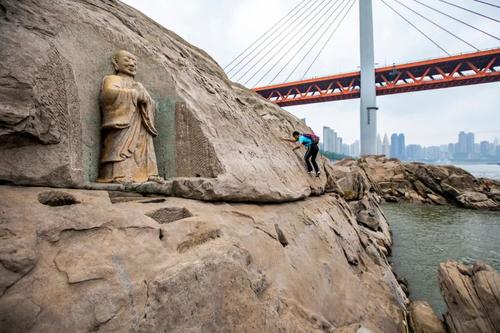
Hugui Stone is oval with 120 meters in length and 80 meters in width. The shape of this stone is similar to a tortoise holding its head high, so it is also called the Tortoise Stone. Hugui means calling someone back. The name of the stone comes from a beautiful myth. It was said that there was a just-married happy couple long ago. After their wedding, there was a violent flood. The husband Da Yu volunteered to control the flood. From then on, he never returned home. His wife stood on the stone slope every day looking forward to her husband's return. As time went on the wife turned into a stone.
Nowadays, there are still mottled marks on the stone, which looks like the wife’s long hair floating in the river. The river is beating against the stone as if the waves are washing her body. The surging river seems to be calling for the return of her husband day and night. The voice of the river seems to cry for the wife: “Yu, come back, come back......!”
Spirit Stone of the Chaotian Gate is situated at the intersection of the Yangtze River and Jialing River outside the Chaotian Gate. It is a rock extending to the center of the Yangtze River, which can only be seen when the water level is extremely low in winter and spring. As the water level rises after the completion of the Three Gorges Project, the spirit stone is more and more difficult to see.
Chaotianmen Yangtze River Bridge→Chaotian Gate Plaza→Chaotian Gate→ Chaotianmen Dock→Ciyun Temple
Take bus 181、382、503、553、871 and get off at Chaotianmen Station.
Take Subway Line 1 and get off at Xiaoshizi Station. Get out from exit A4 and walk about 790 meters to the dock.
Chinese: 请带我去朝天门码头。English: Please take me to the Chaotianmen Dock.
If you go to the Chaotianmen Dock from Chongqing Jiangbei International Airport, it takes about 50 minutes (70 yuan).
If you go to the Chaotianmen Dock from Chongqing North Railway Station, it takes about 43 minutes (40 yuan).
If you go to the Chaotianmen Dock from Chongqing West Railway Station, it takes about 44 minutes (45 yuan).
If you go to the Chaotianmen Dock from Chongqing South Railway Station, it takes about 29 minutes (30 yuan).
If you go to the Chaotianmen Dock from Chongqing East Railway Station, it takes about 56 minutes (50 yuan).
